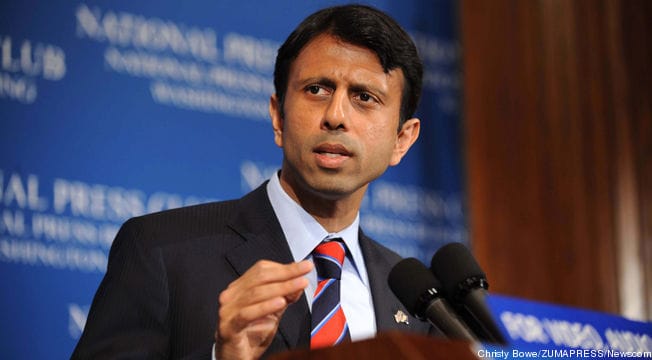That the Recovery School District in New Orleans made the top of the Brookings Institution’s second Education Choice and Competition Index shows how the list has improved from its first showing last year. Russ Whitehurst and his team gathered data on 107 school districts this go-around, up from twenty-five in 2011, and at last included New Orleans, Washington, D.C., and Milwaukee—cities that, not surprisingly, all made this year’s top ten for the way they maximize choice for families of all income levels.
 Gov. Bobby Jindal giving a speech yesterday at Brookings, which coincided with the report's release. Photo from TPMDC. |
But what makes this year’s index worthwhile is the way that Brookings highlighted the differences between even the best. It’s easy to see what separates the Recovery School District from, for instance, Brownsville, Texas, the worst-scoring district on the list and one that provides few alternatives to a zip-code education. The contrast between the Crescent City and Washington, D.C., is more subtle, but Whitehurst argues that it’s still significant.
He’s right. D.C. garnered the third-highest ranking and scored well on its abundance, and funding, of school alternatives (charters and vouchers included). But it fell short in matching families to the schools of their choice. Individual lotteries determine admission to oversubscribed schools, providing more chance than choice; in order to preserve a modicum of choice in this system, parents apply to as many schools as possible, then accept the offer that arrives from their most-preferred school.
Not so in New Orleans, the only city to score an A on the index. A common application is good for all traditional and charter public schools in the Recovery School District, and parents are more likely to gain entry into the school that they ranked highest (it helps that this system was designed by two Nobel Price-winning economists who specialize in match-making). Furthermore, the RSD gets high marks for the information it makes available to parents and for its measurements of student achievement (voucher students take the same tests as public school students; this is not so in D.C.).
None of this is meant to slight the progress made in D.C. when it comes to supporting school choice. Instead, the index shows how schools there, and those in New York, Milwaukee, and Denver (to name just a few districts), can make improvements to help parents find the right school, often without resorting to lawmaking.
To be sure, the architecture of the RSD wasn’t refined overnight, and adult interests remain committed to blocking any further enhancement of parental choice in Louisiana (as Governor Bobby Jindal pointedly said in a speech yesterday at Brookings, which coincided with the report’s release). But Brookings has shown how policies affecting student assignment, funding, and transparency can be changed in small ways to the benefit of kids—if only for states and districts that already are committed to choice. The near-monopolies may have a long way to go, but now we have more insight to aid in the effort towards forward movement.
